King of Nepal
| Mahārājdhirāja of Nepal | |
|---|---|
|
Royal Coat of arms (before 2006) | |
|
Gyanendra Bir Bikram Shah | |
| Details | |
| Style | His Royal Majesty |
| First monarch | Mahārājdhirāja Prithvi Narayan Shah |
| Last monarch | Mahārājdhirāja Gyanendra Bir Bikram Shah |
| Formation | September 25, 1768 |
| Abolition | May 28, 2008 |
| Residence | Narayanhity Royal Palace, Kathmandu, Nepal |
| Appointer | Hereditary |
| Pretender(s) | Mahārājdhirāja Gyanendra Bir Bikram Shah |
The King of Nepal, traditionally known as the Mahārājādhirāja (Nepali: श्री ५ महाराजधिराज), was Nepal's head of state and monarch from 1768 to 2008. He served as the head of the Nepalese monarchy—Shah Dynasty. The monarchy was founded in 1768 and was abolished on 28 May 2008 by the Nepalese Constituent Assembly.[1] The subnational monarchies in Mustang, Bajhang, Salyan, and Jajarkot were also abolished in October. [2]
History
The Kingdom of Nepal was founded on 25 September 1768 by Prithvi Narayan Shah, a Gorkha king who succeeded in unifying the kingdoms of Kathmandu, Patan, and Bhaktapur into a single state under his Shah dynasty. The Kingdom of Nepal was de jure an absolute monarchy for most of its history. However, from 1846 until 1951, the country was de facto ruled by the hereditary Prime Ministers from the Rana dynasty, reducing the role of the Shah monarch to that of a figurehead. In November 1990, after the Jana Andolan movement, the new Constitution was adopted and the country became a constitutional monarchy.
On 13 February 1996, the Nepalese Civil War was launched by the Communist Party of Nepal (Maoist), with the aim of overthrowing the kingdom and establishing a 'People's Republic'. On 1 February 2005, as the security situation deteriorated in the civil war, King Gyanendra declared a state of emergency, suspended the Constitution and assumed direct control over the country.[3] On 24 April 2006, after the Loktantra Andolan movement, the king agreed to give up absolute power and to reinstate the dissolved House of Representatives.[4][5] On 21 November 2006, the Civil War ended with the signing of the Comprehensive Peace Accord.[6] On 15 January 2007, the King was suspended from exercising his duties by the newly formed interim legislature. Finally, on 28 May 2008, the kingdom was officially abolished by the Constituent Assembly and Federal Democratic Republic of Nepal was declared.[7] The subnational monarchies in Mustang, Bajhang, Salyan, and Jajarkot were also abolished in October 2008.[8]
Nepalese royal massacre
On 1 June 2001, Crown Prince Dipendra went on a shooting spree and murdered his father, King Birendra, his mother Queen Aishwarya, and several other members of the royal family. Afterwards, he shot himself.[9][10] Immediately after the massacre, Dipendra was proclaimed king while in a coma, but he died on 4 June 2001, after a three-day reign.[11] His uncle, Prince Gyanendra, was appointed regent for the three days, then ascended the throne himself after Dipendra died.
Kings of Nepal (1768–2008)
| Name |
Lifespan |
Reign start |
Reign end |
Notes |
Family |
Image |
|---|---|---|---|---|---|---|
Prithvi Narayan Shah
|
7 January 1723[12] – 11 January 1775 (aged 52) | 25 September 1768 | 11 January 1775 | Son of Nara Bhupal Shah | Shah | 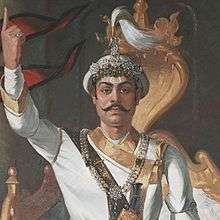 |
Pratap Singh Shah
|
16 April 1751 – 17 November 1777 (aged 26) | 11 January 1775 | 17 November 1777 | Son of Prithvi Narayan Shah | Shah |  |
Rana Bahadur Shah
|
25 May 1775 – 25 April 1806 (aged 30) | 17 November 1777 | 8 March 1799 (abdicated) |
Son of Pratap Singh Shah | Shah | 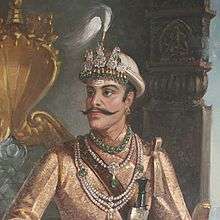 |
Girvan Yuddha Bikram Shah
|
19 October 1797 – 20 November 1816 (aged 19) | 8 March 1799 | 20 November 1816 | Son of Rana Bahadur Shah | Shah | 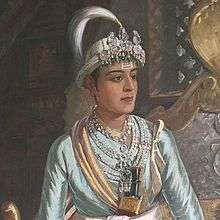 |
Rajendra Bikram Shah
|
3 December 1813 – 10 July 1881 (aged 67) | 20 November 1816 | 12 May 1847 (abdicated) |
Son of Girvan Yuddha Bikram Shah | Shah | 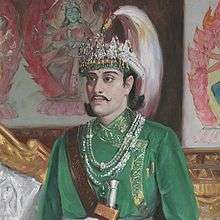 |
Surendra Bikram Shah
|
20 October 1829 – 17 May 1881 (aged 51) | 12 May 1847 | 17 May 1881 | Son of Rajendra Bikram Shah | Shah |  |
Prithvi Bir Bikram Shah
|
18 August 1875 – 11 December 1911 (aged 36) | 17 May 1881 | 11 December 1911 | Grandson of Surendra Bikram Shah | Shah | 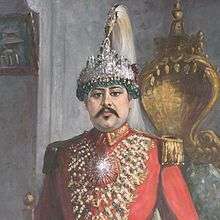 |
| Tribhuvan Bir Bikram Shah (1st reign)
|
30 June 1906 – 13 March 1955 (aged 48) | 11 December 1911 | 7 November 1950 (went into exile) |
Son of Prithvi Bir Bikram Shah | Shah |  |
| Gyanendra Bir Bikram Shah (1st reign)
|
7 July 1947 | 7 November 1950 | 7 January 1951 (stepped down) |
Grandson of Tribhuvan Bir Bikram Shah | Shah |  |
| Tribhuvan Bir Bikram Shah (2nd reign)
|
30 June 1906 – 13 March 1955 (aged 48) | 7 January 1951 | 13 March 1955 | Son of Prithvi Bir Bikram Shah | Shah |  |
Mahendra Bir Bikram Shah
|
11 June 1920 – 31 January 1972 (aged 51) | 14 March 1955 | 31 January 1972 | Son of Tribhuvan Bir Bikram Shah | Shah | 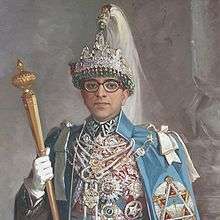 |
Birendra Bir Bikram Shah
|
28 December 1945 – 1 June 2001 (aged 55) | 31 January 1972 | 1 June 2001 (assassinated) |
Son of Mahendra Bir Bikram Shah | Shah | 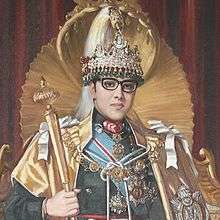 |
Dipendra Bir Bikram Shah[13]
|
27 June 1971 – 4 June 2001 (aged 29) | 1 June 2001 | 4 June 2001 | Son of Birendra Bir Bikram Shah | Shah |  |
| Gyanendra Bir Bikram Shah (2nd reign)
|
7 July 1947 | 4 June 2001 | 28 May 2008 (deposed) |
Son of Mahendra Bir Bikram Shah | Shah |  |
Note
Prithvi Narayan Shah was the first ruler of "unified" Nepal. However, prior to 1768, the modern-day Nepal consisted of various small kingdoms, among which Shah Kings continued to rule in a few of them (notably in Gorkha). So the actual history of the Shah dynasty dates much before Prithvi Narayan Shah.[14]
Royal Standard
 Royal Standard of Nepal.
Royal Standard of Nepal.
See also
- List of heads of state of Nepal, for a comprehensive list of Nepalese heads of state since 1768
- President of Nepal
- List of Prime Ministers of Nepal
- Kingdom of Nepal
- Coronation of the Nepalese monarch
- Line of succession to the former Nepalese throne
- Nepalese royal massacre
- Rastriya Prajatantra Party Nepal
References
- ↑ Nepal votes to abolish monarchy
- ↑ Abolishment of subnational monarchies
- ↑ Staff writer (2005-02-01). "Nepal's king declares emergency". BBC News.
- ↑ Sengupta, Somini (25 April 2006). "In a Retreat, Nepal's King Says He Will Reinstate Parliament". The New York Times.
- ↑ "Full text: King Gyanendra's speech". BBC. 24 April 2006.
- ↑ "Peace deal ends Nepal's civil war". BBC News. 21 November 2006. Retrieved 22 November 2006.
- ↑ Nepal votes to abolish monarchy
- ↑ Abolishment of subnational monarchies
- ↑ Rahul Bedi; Alex Spillius (8 June 2001). "Massacre witness blames Crown Prince". The Daily Telegraph. Retrieved 28 May 2008.
- ↑ "Nepal survivors blame prince". BBC News. 7 June 2001. Retrieved 31 May 2009.
- ↑ "Nepal mourns slain king". BBC News. 2 June 2001. Retrieved 31 May 2009.
- ↑ Accordingly Royal Ark, he was born on 25 December 1722
- ↑ Reigned whilst in a coma, following the royal massacre
- ↑ "The History of Nepal".
.jpg)